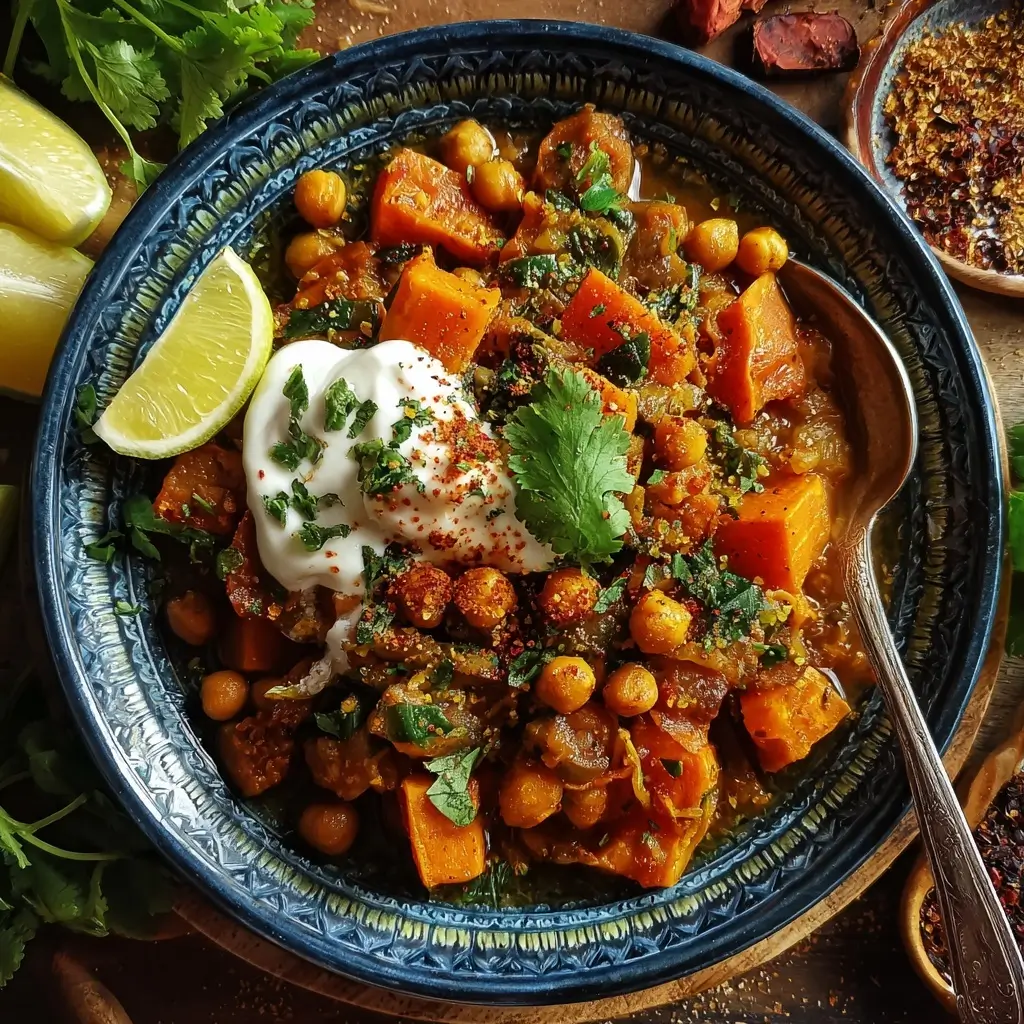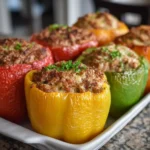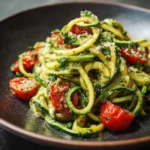Moroccan Chickpea & Sweet Potato Tagine: A Flavorful Journey Through Tradition and Taste
The History of Tagine: A Culinary Heritage from Morocco
The Moroccan tagine is more than just a dish—it’s a culinary tradition steeped in centuries of cultural exchange, regional diversity, and communal dining. Originating from North Africa, particularly Morocco, the word “tagine” refers both to the conical clay cooking vessel and the slow-cooked stew prepared within it. This unique pot, often glazed and handcrafted by local artisans, allows steam to circulate and condense back into the dish, preserving moisture and intensifying flavors without the need for excess oil or liquid.
Historically, tagines have been central to Moroccan family meals and hospitality rituals. The roots of this cooking method date back to the Berber people, the indigenous inhabitants of North Africa, who developed the technique to make the most of limited resources in arid climates. Over time, Arab, Andalusian, Moorish, and Mediterranean influences enriched the cuisine, introducing aromatic spices like cumin, cinnamon, ginger, saffron, and coriander. These ingredients were not only prized for their flavor but also for their preservative qualities and medicinal benefits.
Chickpeas and sweet potatoes—staples in modern vegetarian tagines—have long been part of Moroccan agriculture. Chickpeas were cultivated across the region since ancient times, while sweet potatoes, though originally from the Americas, were integrated into North African cooking after trade routes expanded during the Columbian Exchange. Today, the chickpea and sweet potato tagine stands as a symbol of Morocco’s evolving yet deeply rooted culinary identity—a harmonious blend of earthy legumes, tender root vegetables, and fragrant spices, all slow-simmered into a comforting, soul-warming meal.
Ingredients Breakdown: Building Layers of Flavor
The magic of Moroccan chickpea and sweet potato tagine lies in its layered complexity, where each ingredient contributes to a symphony of taste, texture, and aroma. Here’s a detailed breakdown of the components that make this dish so special:
- Chickpeas (Garbanzo Beans): Whether canned or dried and soaked, chickpeas are rich in protein, fiber, and essential minerals. They absorb the surrounding spices beautifully, adding heartiness and substance to the tagine.
- Sweet Potatoes: Orange-fleshed sweet potatoes bring natural sweetness, vibrant color, and creamy texture. Their sugars caramelize slightly during cooking, balancing the warm spices and enhancing the overall depth of flavor.
- Olive Oil: Used as the base fat, extra virgin olive oil adds richness and helps bloom the spices early in the cooking process, unlocking their full aromatic potential.
- Onions: Yellow or red onions form the savory foundation. When sautéed slowly, they become translucent and sweet, creating a soft bed for other ingredients.
- Garlic: Fresh garlic cloves add pungency and warmth, elevating the umami profile of the dish.
- Ginger: Freshly grated ginger offers a bright, zesty kick with subtle heat, characteristic of Moroccan spice blends.
- Tomatoes: Diced canned tomatoes or fresh ripe tomatoes provide acidity and juiciness, helping to create a luscious sauce.
- Vegetable Broth: Enhances moisture and adds savory depth without overpowering the delicate spice balance.
- Spices – The Soul of the Dish:
- Ground Cumin: Earthy and nutty, cumin is a cornerstone of Moroccan seasoning.
- Ground Coriander: Citrusy and floral, it complements cumin perfectly.
- Paprika: Adds mild sweetness and a deep red hue.
- Ground Cinnamon: Warm and slightly sweet, it ties the dish together, especially with sweet potatoes.
- Ground Turmeric: Offers a golden color and subtle bitterness, along with anti-inflammatory properties.
- Cayenne Pepper (optional): For those who enjoy a touch of heat.
- Saffron Threads (optional but traditional): Soaked in warm water, saffron imparts a luxurious aroma, golden tint, and distinctive flavor associated with royal Moroccan feasts.
- Dried Apricots or Prunes: These dried fruits introduce a gentle fruitiness that contrasts beautifully with the spices. Apricots add tang; prunes lend deeper molasses-like notes.
- Lemon Juice: A splash at the end brightens the entire dish, cutting through richness and enhancing freshness.
- Fresh Herbs: Cilantro and parsley are commonly used for garnish, offering a burst of green, herbal vibrancy.
- Almonds (optional): Toasted sliced or slivered almonds can be sprinkled on top for crunch and elegance, reflecting the Andalusian influence.
Step-by-Step Recipe: Crafting Your Own Moroccan Masterpiece
Now that we’ve explored the heritage and ingredients, let’s dive into how to make an authentic, deeply flavorful Moroccan chickpea and sweet potato tagine right in your kitchen—even if you don’t own a traditional clay tagine!
Ingredients
- 2 tablespoons extra virgin olive oil
- 1 large yellow onion, finely chopped
- 4 garlic cloves, minced
- 1 tablespoon fresh ginger, grated
- 2 medium sweet potatoes (about 500g), peeled and cut into 1-inch cubes
- 1 can (15 oz / 400g) chickpeas, drained and rinsed (or 1.5 cups cooked)
- 1 cup diced canned tomatoes (with juice)
- 2 teaspoons ground cumin
- 1.5 teaspoons ground coriander
- 1 teaspoon paprika
- 1 teaspoon ground cinnamon
- ½ teaspoon ground turmeric
- ¼ teaspoon cayenne pepper (adjust to taste)
- A pinch of saffron threads (optional), soaked in 2 tbsp warm water
- 1.5 cups vegetable broth
- ½ cup dried apricots, halved (or pitted prunes)
- 1 tablespoon lemon juice
- Salt and freshly ground black pepper, to taste
- Fresh cilantro and flat-leaf parsley, chopped (for garnish)
- Toasted slivered almonds (optional, for topping)
Directions
- Sauté the Aromatics: In a large heavy-bottomed pot or Dutch oven over medium heat, warm the olive oil. Add the chopped onion and cook gently for 6–8 minutes, stirring occasionally, until soft and golden. Stir in the garlic and ginger, cooking for another minute until fragrant.
- Bloom the Spices: Add the cumin, coriander, paprika, cinnamon, turmeric, and cayenne. Stir constantly for about 1 minute to toast the spices, releasing their essential oils and deepening their flavor. Be careful not to burn them.
- Add Vegetables and Tomatoes: Toss in the cubed sweet potatoes, stirring to coat them evenly with the spiced oil mixture. Pour in the diced tomatoes with their juice and stir well to combine.
- Incorporate Liquids: Add the vegetable broth and soaked saffron (including the water). Stir thoroughly, scraping any browned bits from the bottom of the pot. Season lightly with salt and pepper—remember, broth may already contain salt.
- Simmer Gently: Bring the mixture to a gentle boil, then reduce the heat to low. Cover the pot and simmer for 20 minutes, stirring occasionally, until the sweet potatoes begin to soften.
- Add Chickpeas and Dried Fruit: Stir in the drained chickpeas and dried apricots (or prunes). Continue to cook, covered, for another 15–20 minutes, or until the sweet potatoes are fork-tender and the sauce has thickened into a rich, glossy stew.
- Finish with Brightness: Remove from heat. Stir in the lemon juice to enhance the flavor profile. Taste and adjust seasoning—add more salt, pepper, or a pinch of sugar if needed to balance the acidity.
- Garnish and Serve: Sprinkle generously with chopped fresh cilantro and parsley. For added texture and visual appeal, scatter toasted slivered almonds on top before serving.
Tips for the Perfect Tagine Every Time
- Use a Heavy Pot: If you don’t have a tagine, use a Dutch oven or a deep, lidded skillet with good heat retention to mimic the slow, even cooking of traditional earthenware.
- Don’t Rush the Onions: Slowly caramelizing the onions builds a deeper flavor base. Take your time in the first step.
- Bloom Spices Properly: Toasting spices in oil activates their volatile compounds. But keep the heat moderate—burnt spices turn bitter.
- Cut Uniform Pieces: Ensure sweet potatoes are cut evenly so they cook at the same rate—nobody wants mushy corners next to hard chunks!
- Adjust Consistency: If the tagine becomes too thick, add a splash more broth or water. If too thin, simmer uncovered for a few extra minutes.
- Rest Before Serving: Let the tagine sit off the heat for 10 minutes before serving. This allows flavors to meld further and improves overall taste.
- Make It Ahead: Like many stews, this tagine tastes even better the next day. Prepare it a day in advance and reheat gently on the stove.
- Serve Warm, Not Scorching: Tagines are traditionally served warm but not piping hot, allowing nuances of spice and fruit to shine.
Variations and Customizations: Make It Yours
One of the greatest strengths of this recipe is its adaptability. Feel free to personalize it based on dietary preferences, seasonal availability, or cultural twists:
- Vegan & Gluten-Free Friendly: Naturally plant-based and gluten-free (check broth labels), this tagine suits various diets effortlessly.
- Add More Veggies: Include carrots, zucchini, bell peppers, or cauliflower for additional color and nutrition.
- Protein Boost: While already high in protein from chickpeas, you can add lentils, tofu, or even shredded chicken for a non-vegetarian version.
- Coconut Milk Twist: Replace half the broth with full-fat coconut milk for a creamier, slightly tropical variation—popular in some coastal regions of Morocco.
- Smoky Flavor: Add a small piece of smoked paprika or a drop of liquid smoke for a deeper, campfire-like note.
- Preserved Lemon: For authenticity, stir in 1–2 tablespoons of chopped preserved lemon (rind only, rinsed) during the last 10 minutes of cooking. Its intense salty-citrus punch is a hallmark of Moroccan cuisine.
- Herb Variations: Mint can be used alongside or instead of cilantro for a refreshing twist.
- Spice Level: Omit cayenne entirely for a mild version, or add harissa paste (1–2 tsp) for fiery North African heat.
- Fruit Swaps: Try dates, raisins, or figs instead of apricots for different levels of sweetness and chewiness.
Health Considerations and Nutritional Value
This Moroccan chickpea and sweet potato tagine isn’t just delicious—it’s a powerhouse of nutrients that supports long-term health and wellness.
Nutritional Highlights (per serving, approx. 1.5 cups):
- Calories: ~300–350 kcal
- Protein: 10–12g (from chickpeas and legumes)
- Fiber: 8–10g (excellent for digestion and satiety)
- Complex Carbohydrates: From sweet potatoes and chickpeas, providing sustained energy release.
- Healthy Fats: Monounsaturated fats from olive oil support heart health.
- Vitamins:
- Vitamin A (from beta-carotene in sweet potatoes): crucial for vision and immune function.
- Vitamin C (from tomatoes and lemon): antioxidant and collagen synthesis.
- B Vitamins (especially folate from chickpeas): important for metabolism and cell repair.
- Minerals:
- Potassium: helps regulate blood pressure.
- Iron: vital for oxygen transport (enhanced absorption when paired with vitamin C-rich lemon juice).
- Magnesium and Phosphorus: involved in bone health and enzyme activity.
Health Benefits of Key Ingredients:
- Chickpeas: Linked to improved gut microbiome, reduced cholesterol, and better blood sugar control due to high soluble fiber content.
- Sweet Potatoes: Low glycemic index compared to white potatoes, making them suitable for diabetics when portion-controlled.
- Spices: Cumin and turmeric have anti-inflammatory and antimicrobial properties. Cinnamon may help regulate insulin sensitivity.
- Olive Oil: Rich in polyphenols and linked to lower risk of cardiovascular disease.
- Dried Apricots: Provide iron and potassium, though consume in moderation due to natural sugars.
Dietary Notes:
- Diabetic-Friendly? Yes, in controlled portions. Pair with whole grains like quinoa instead of couscous for better glucose management.
- Weight Management: High fiber and protein promote fullness, reducing overeating tendencies.
- Allergen Info: Naturally nut-free unless topped with almonds. Use seed-based toppings (e.g., pumpkin seeds) if needed.
Frequently Asked Questions (FAQ)
Can I make this tagine in a slow cooker or Instant Pot?
Absolutely! For a slow cooker, sauté onions, garlic, and spices first, then transfer to the crockpot with remaining ingredients (except lemon juice and herbs). Cook on low for 6–7 hours or high for 3–4 hours. Stir in lemon juice before serving.
For the Instant Pot, use the Sauté function for steps 1–3, then add all remaining ingredients except lemon juice. Seal and cook on Manual/High Pressure for 10 minutes, followed by a natural release for 10 minutes. Quick-release any remaining pressure, open, and stir in lemon juice.
What should I serve with tagine?
Traditional pairings include:
- Couscous (whole wheat or regular)
- Quinoa or brown rice for a healthier option
- Warm pita bread or Moroccan khobz (flatbread)
- Fresh salad with orange segments, red onion, and mint
How long does it keep?
Store cooled tagine in an airtight container in the refrigerator for up to 5 days. Freeze for up to 3 months. Reheat gently on the stove with a splash of water or broth to restore consistency.
Why is my tagine too watery or too dry?
If too watery, simmer uncovered for 10–15 minutes to reduce the liquid. If too dry, add ¼–½ cup vegetable broth or water and stir gently to reincorporate.
Can I use fresh tomatoes instead of canned?
Yes! Use 2–3 ripe Roma or plum tomatoes, blanched, peeled, seeded, and diced. You may need to simmer longer to break them down fully.
Is saffron necessary?
No, but it adds a luxurious depth and historical authenticity. Substitute with a pinch of turmeric for color, though the flavor will differ.
Can I use other beans?
Yes—white beans, lentils, or kidney beans work well. Adjust cooking times accordingly.
Summary
Indulge in the aromatic richness of Moroccan chickpea and sweet potato tagine—a nourishing, plant-powered stew layered with warming spices, tender vegetables, and sweet-tart dried fruits. Rooted in centuries-old traditions yet perfectly suited for modern kitchens, this dish brings the soul of North Africa to your table with every fragrant bite.










